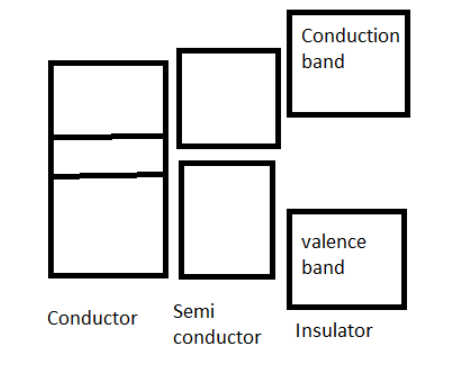
Define valence band, conduction and energy gap (forbidden energy band gap).
Answer
472.8k+ views
Hint: The terms valence band, conduction and energy gap (forbidden energy band gap) arise from the band theory. This theory distinguishes between the conductors, semiconductors and insulators.
Complete Step by step answer: For the particle of a certain matter, the valence band represents the furthest electron orbital in which electrons are present.
In a solid crystal lattice, the conduction band represents the delocalized band containing energy levels and is incompletely filled with electrons. These highly mobile electrons lead to the electrical conductivity.
Thus, a band of electron orbitals form a conduction band. The electrons are excited from the valence band to the conduction band. In the conduction band, the electrons are free to move throughout the crystal lattice as they have sufficient energy. Due to the free movement of electrons, an electric current is produced.
The energy gap (forbidden energy band gap) is the difference in the energy between the highest occupied valence band and the lowest unoccupied conduction band. The electrical conductivity of the material depends on this energy gap.

Note: Metals are good electrical conductors as they have small energy gaps. Non-metals are insulators as they have large energy gaps. The energy gap of semiconductors is in between the energy gap of conductors and insulators.
Complete Step by step answer: For the particle of a certain matter, the valence band represents the furthest electron orbital in which electrons are present.
In a solid crystal lattice, the conduction band represents the delocalized band containing energy levels and is incompletely filled with electrons. These highly mobile electrons lead to the electrical conductivity.
Thus, a band of electron orbitals form a conduction band. The electrons are excited from the valence band to the conduction band. In the conduction band, the electrons are free to move throughout the crystal lattice as they have sufficient energy. Due to the free movement of electrons, an electric current is produced.
The energy gap (forbidden energy band gap) is the difference in the energy between the highest occupied valence band and the lowest unoccupied conduction band. The electrical conductivity of the material depends on this energy gap.

Note: Metals are good electrical conductors as they have small energy gaps. Non-metals are insulators as they have large energy gaps. The energy gap of semiconductors is in between the energy gap of conductors and insulators.
Recently Updated Pages
The correct geometry and hybridization for XeF4 are class 11 chemistry CBSE

Water softening by Clarks process uses ACalcium bicarbonate class 11 chemistry CBSE

With reference to graphite and diamond which of the class 11 chemistry CBSE

A certain household has consumed 250 units of energy class 11 physics CBSE

The lightest metal known is A beryllium B lithium C class 11 chemistry CBSE

What is the formula mass of the iodine molecule class 11 chemistry CBSE

Trending doubts
State the laws of reflection of light

One Metric ton is equal to kg A 10000 B 1000 C 100 class 11 physics CBSE

Difference Between Prokaryotic Cells and Eukaryotic Cells

What is the modal class for the following table given class 11 maths CBSE

How do I convert ms to kmh Give an example class 11 physics CBSE

Give an example of a solid solution in which the solute class 11 chemistry CBSE




